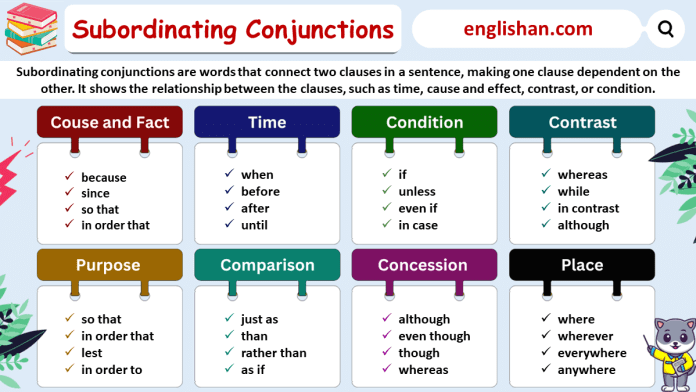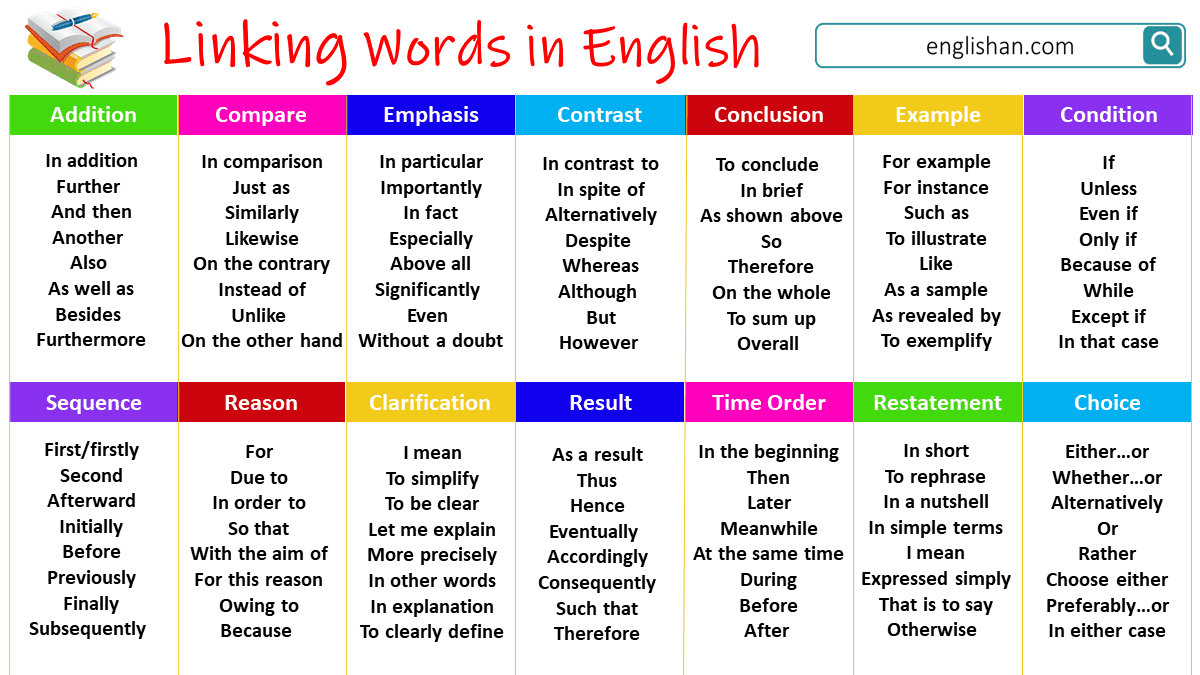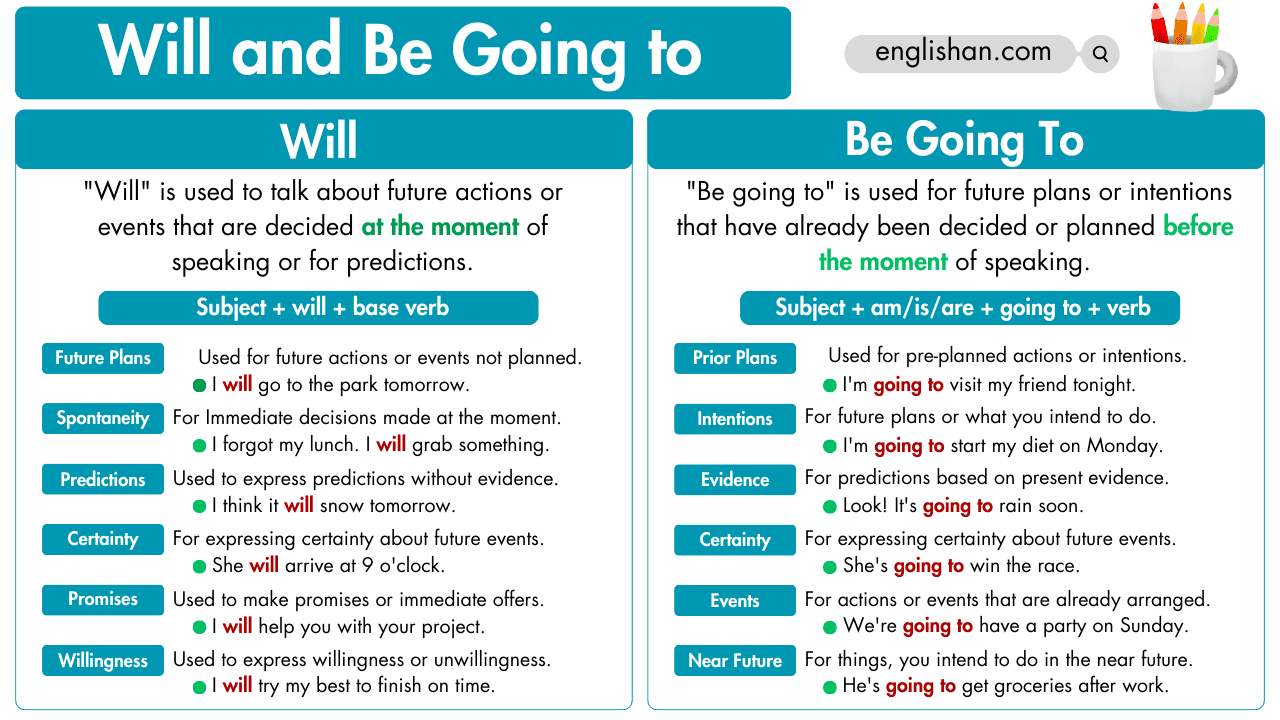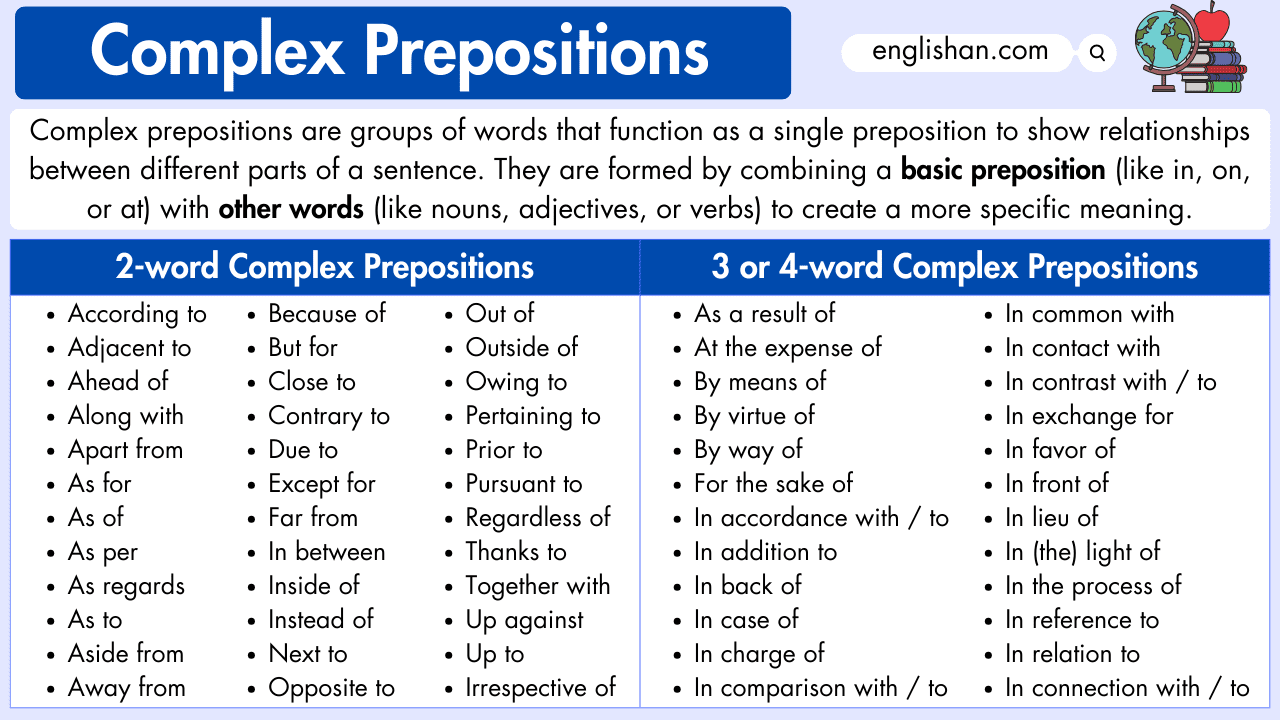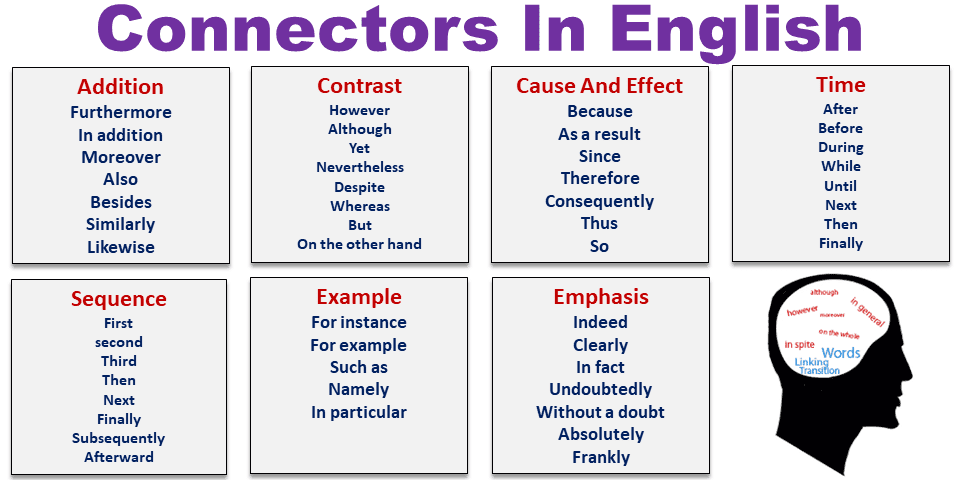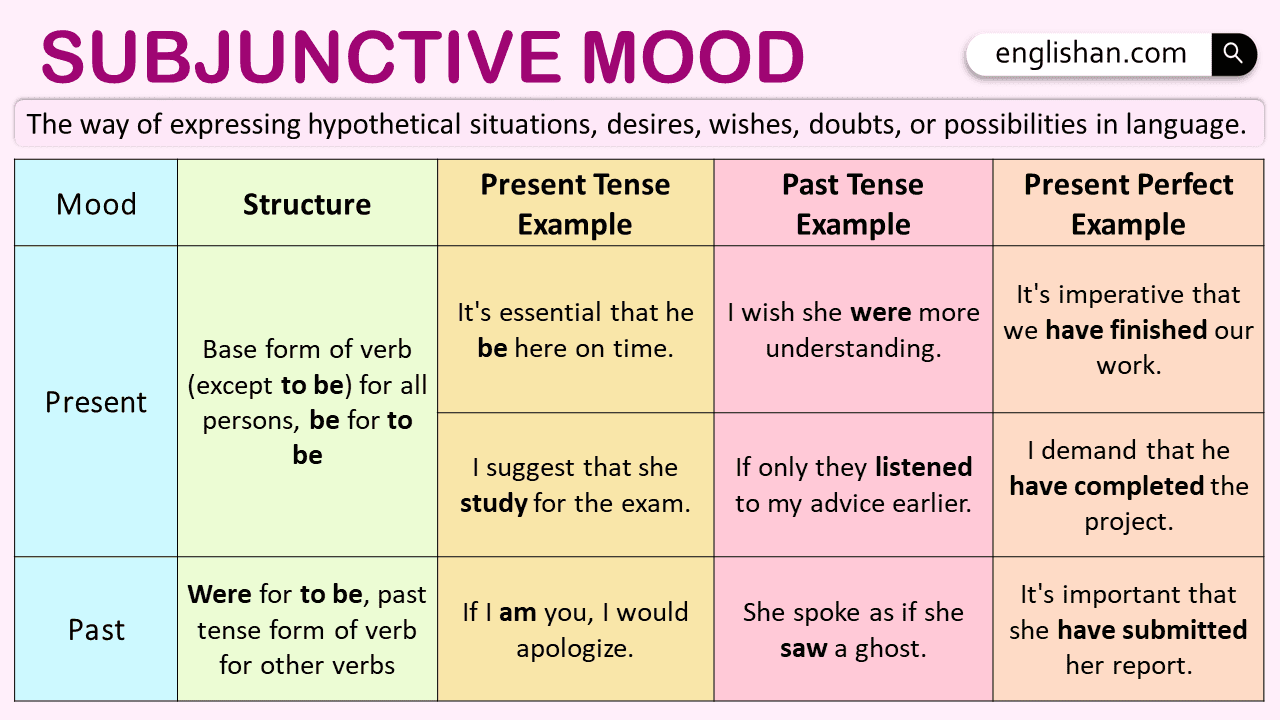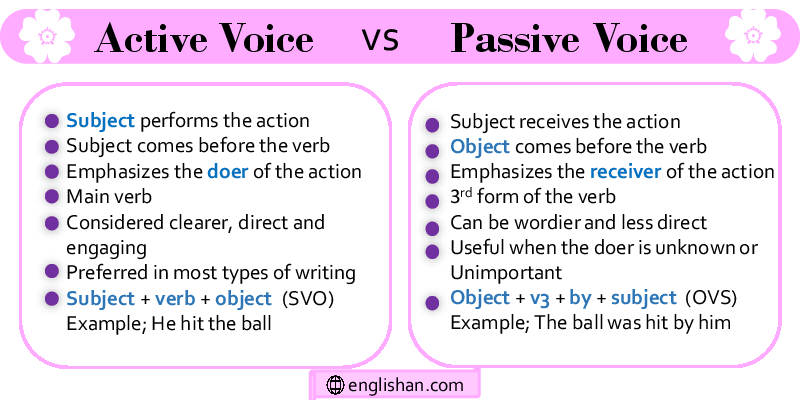Contents
Subordinating conjunctions are essential components of the English language that help to connect dependent clauses to independent clauses. These conjunctions, also known as subordinators, play a crucial role in clarifying the relationship between the two clauses. In this article, we’ll explore some common subordinating conjunctions and how to use them effectively with rules and examples. So let’s get started!
What Are Subordinating Conjunctions?
Subordinating conjunctions are words that connect two clauses in a sentence and show a relationship of dependence between them. They introduce a subordinate (dependent) clause and indicate how it relates to the main (independent) clause. They help express time, cause and effect, contrast, condition, and other relationships within a sentence.
There are two types of clauses in a sentence: independent clauses, which can stand alone as complete sentences, and dependent clauses, which cannot stand alone and need an independent clause to make a complete thought. By using subordinating conjunctions, you can create more complex and meaningful sentences in the English language.
Here’s a simple example: “I will go to the park (main clause) when it stops raining (subordinate clause).” In this sentence, “when” is the subordinating conjunction, connecting the two clauses and showing the time relationship between them. Some common examples of subordinating conjunctions include “because,” “although,” “if,” “when,” and “since” etc.
Examples:
- We stayed inside because it was too cold.
- I’ll eat dinner wherever you want to go.
- Before I go to bed, I always brush my teeth.
- If you study hard, you will pass the exam.
- I will wait until you finish your meeting.
Usage of Subordinating Conjunctions
Subordinating conjunctions are words that connect two parts of a sentence. They help make sentences more interesting and clear. Below are the main ways we use subordinating conjunctions:
Cause and Effect
Subordinating conjunctions like because and since show why something happens. They explain the reason for an action.
- She went to bed early because she was tired.
The second part of the sentence (“she was tired”) tells us why she went to bed early.
Showing Time
Conjunctions like when, while, and after help show when something happens. They connect events in time.
- I will call you when I get home.
The second part (“when I get home”) tells us the time for the first action (“I will call you”).
Expressing Condition
Words like if, unless, and provided that show conditions. They tell us when something will happen depending on a certain situation.
- If it rains, we will stay indoors.
The second part (“if it rains”) explains the condition for the action in the first part (“we will stay indoors”).
Showing Contrast
Conjunctions like although, while, and though help show differences between two ideas or actions.
- Although it was raining, they decided to go for a walk.
The second part (“it was raining”) shows a contrast to the action in the first part (“they decided to go for a walk”).
Depicting Purpose
Conjunctions like so that and in order that explain why something is done. They show the reason for an action.
- She studied hard so that she could pass the test.
The second part (“so that she could pass the test”) tells us the reason why she studied hard.
Providing Concessions
These conjunctions show that something is true, but the main action still happens. Words like although and even though are used.
- Although it was raining, they went for a walk.
The second part (“it was raining”) gives us a reason to expect they wouldn’t go for a walk, but the first part (“they went for a walk”) shows that they still did.
Comparison
Words like than and as are used to compare things or actions.
- She is taller than her brother.
The second part (“than her brother”) compares her height to her brother’s height.
Describing Location
Conjunctions like where and wherever help explain where something happens.
- I’ll meet you where we first met.
The second part (“where we first met”) tells us the place for the meeting.
Subordinating Conjunction Rules
- Don’t Separate Clauses: Avoid placing a full stop between the main and subordinate clauses.
- Connect Clauses: Subordinating conjunctions link two clauses in a sentence.
- Dependency: One clause relies on the other for complete meaning.
- Order: The main clause often comes before the subordinate (dependent) clause.
- Comma Use: If the subordinate clause comes first, use a comma to separate it.
- No Comma: If the main clause comes first, no comma is needed.
- Position: They often appear at the beginning of the subordinate (dependent) clause.
- Avoid Comma Splices: Don’t connect two independent clauses with a comma alone.
- Use Parallel Structure: Maintain a parallel structure to connect ideas for a smoother flow.
- Choose the Right Conjunction: Select a subordinating conjunction that fits the relationship between the clauses.
List of Subordinating Conjunctions
Understanding the various subordinating conjunctions is essential for constructing clear and meaningful sentences. Here is a list of commonly used subordinating conjunctions:
- after
- although
- as
- as if
- as long as
- as much as
- as soon as
- as though
- as well as
- because
- before
- by the time
- even if
- even though
- if
- since
- in case
- in order that
- insofar as
- just as
- lest
- now
- no matter how
- now that
- or
- once
- only if
- provided that
- rather than
- since
- so that
- supposing
- than
- that
- though
- till
- unless
- until
- when
- whenever
- where
- whereas
- wherever
- whether
- while
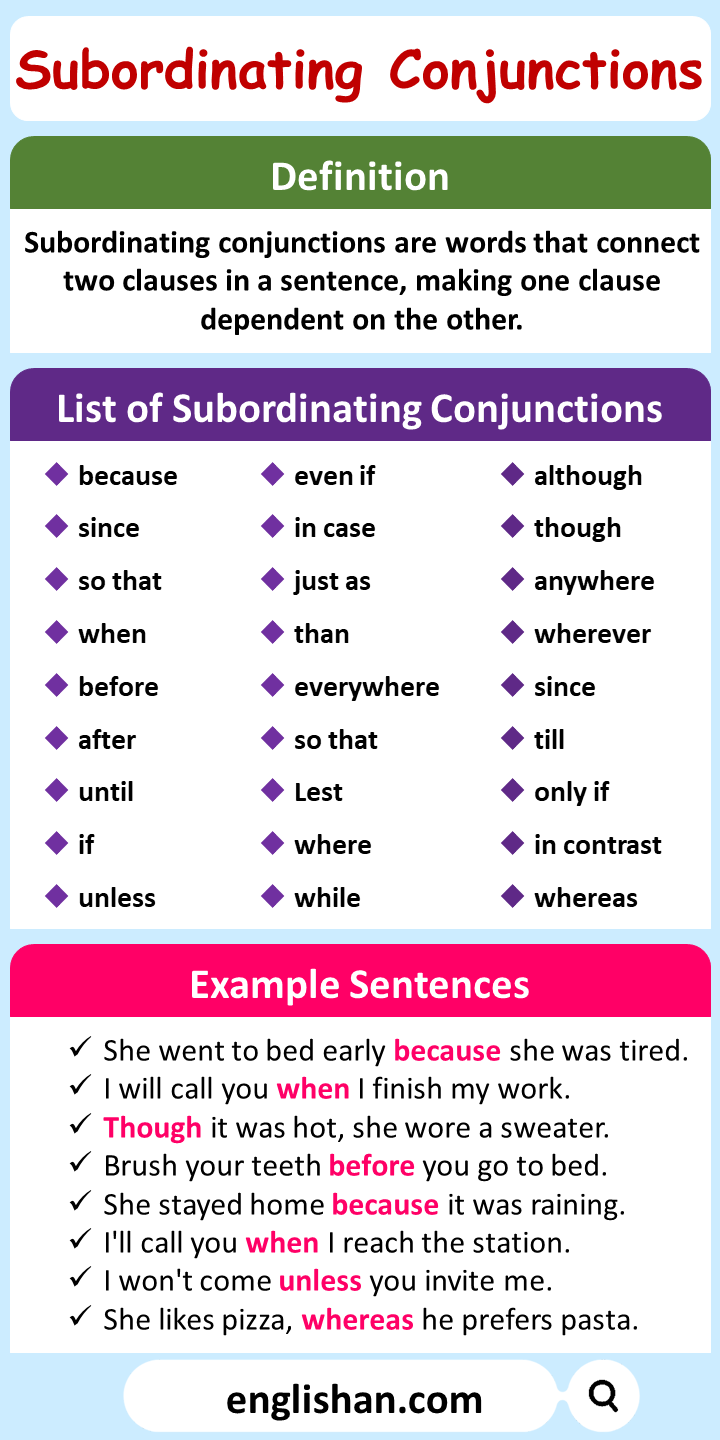
Learn More About Some Common Subordinators
Because: Indicates a cause-and-effect relationship.
- She went inside because it was raining.
Although: Introduces a contrast or an unexpected situation.
- Although it was sunny, she carried an umbrella.
If: Expresses a condition or introduces a hypothetical situation.
- If it rains, we will cancel the picnic.
When: Refers to a specific point in time.
- I will call you when I reach the station.
While: Highlights a contrast or simultaneous actions.
- She likes to read while he prefers to watch TV.
Before: Indicates something happening prior to another event.
- Finish your homework before you go out to play.
Since: Denotes a cause-and-effect relationship or a specific point in time in the past.
- She’s been tired since she woke up early.
Unless: Expresses a condition, often with a negative implication.
- I won’t go out unless it stops raining.
Whereas: Introduces a sharp contrast or comparison.
- She likes coffee, whereas he prefers tea.
Where: Specifies a place or location.
- I’ll meet you where we first met.
As: Indicates a reason, manner, or simultaneous action.
- She spoke softly as not to wake the baby.
After: Denotes something happening subsequent to another event.
- After she finished her meal, she went for a walk.
Tips for Using Subordinating Conjunctions
- Identify the Main and Subordinate Clauses: Understanding the distinction between the main and subordinate clauses is crucial for placing the subordinating conjunction correctly.
- Consider the Relationship: Choose the subordinating conjunction that accurately reflects the relationship between the clauses, whether it’s time, cause and effect, contrast, or condition.
- Choose Appropriate Conjunctions: Select subordinating conjunctions that precisely convey the relationship you want to express. Different conjunctions indicate different connections.
- Punctuation Matters: When a subordinate clause precedes the main clause, use a comma to separate them. If the main clause comes first, no comma is needed.
- Practice Varied Usage: Experiment with different subordinating conjunctions to convey the same relationship. This can enhance your command of language and make your writing more dynamic.
Subordinating Conjunctions Examples
- She went to bed early because she was tired.
- I will call you when I finish my work.
- Though it was hot, she wore a sweater.
- Brush your teeth before you go to bed.
- She stayed home because it was raining.
- If you overeat, you might feel sick.
- I’ll call you when I reach the station.
- I won’t come unless you invite me.
- She likes pizza, whereas he prefers pasta.
- I’ll go for a walk whether it rains or not.
- Although the movie was long, they enjoyed it.
- She smiled because she was happy.
- After the storm passed, they went outside.
- I’ll be happy when I see you again.
- Call me when you arrive at the airport.
- Finish your dinner before you have dessert.
FAQs:
A subordinating conjunction connects two parts of a sentence: one that can stand alone (independent clause) and one that can’t (dependent clause). It shows how the parts are related.
Examples:
1. I stayed home because it was raining.
2. Although it was late, we went to the park.
3. I will go if you come.
4. I will call you when I get home.
5. She read a book while waiting.
These words help connect ideas in a sentence.
Here are 12 subordinating conjunctions:
1. Because
2. Although
3. If
4. When
5. While
6. Since
7. Unless
8. Before
9. After
10. As
11. Even though
12. Until
A subordinating conjunction is a word that connects two parts of a sentence. It helps show how one part depends on the other.
For example:
1. I stayed home because it was raining. (Tells why.)
2. I will go if you come. (Tells when or what happens.)
3. Although it was cold, we went outside. (Shows a difference.)
These words help make sentences clear and interesting!
Read More
